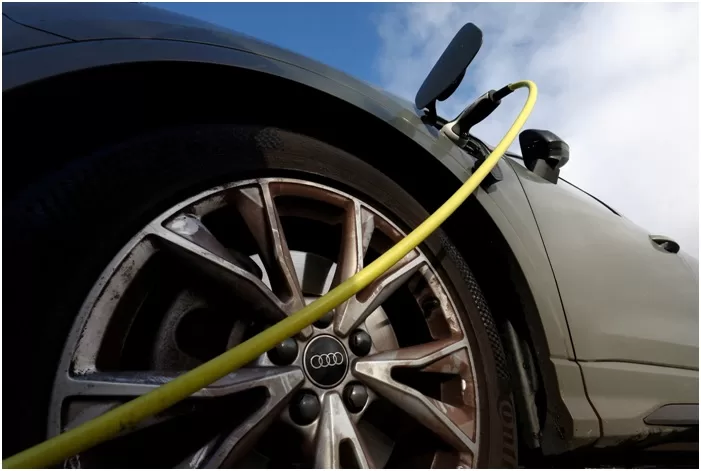Evolving Roadmap: Challenges and Shifts in the Electric Vehicle Revolution

Highlights
- Automakers set to invest $1.2 trillion by 2030 for mass-market EV models, but current challenges prompt reassessment.
- Legacy automakers, along with leading EV companies like Tesla and Rivian, face unexpected hurdles, seeking increased support from policymakers to offset high EV transition costs.
- Global consumer demand for EVs is on the rise, but adoption is slower and less profitable than anticipated, with high-interest rates rendering many EVs financially inaccessible for middle-income consumers.
- Lack of extensive charging infrastructure acts as a barrier to EV adoption, prompting the industry to address accessibility challenges.
- CEOs of major automakers are tempering goals of achieving all-electric fleets by the mid-2030s, emphasizing adaptability to align with evolving consumer preferences.
- Ford’s F-150 Lightning faces production adjustments, highlighting the disparity between initial enthusiasm and sustained demand.
- Global EV production is set to triple by 2030, led by China, where government subsidies and competitive pricing are making EVs more accessible.
- North American projections indicate a potential sixfold increase in EV production by 2030, with industry lobbying for reconsideration of emissions rules.
- Affordability and charging infrastructure emerge as primary concerns, with collaboration agreements with Tesla underscoring the urgency to address charging challenges.
- “Affordability” becomes central as automakers aim to balance production costs and consumer willingness to pay, even leading Tesla to reduce prices.
- The uncertain road ahead requires a reassessment of emissions rules, with overcoming affordability barriers and expanding charging infrastructure pivotal for the success of the EV revolution.
Evolving Roadmap: Challenges and Shifts in the Electric Vehicle Revolution
In a pivotal year for the automotive industry, the once-clear path toward an all-electric future has encountered unexpected twists and turns. As 2023 draws to a close, automakers, both established and emerging, find themselves reassessing strategies amid unforeseen challenges in the pursuit of mass-market electric vehicle (EV) adoption.
Investment Realities
At the outset of the year, industry players were gearing up to inject a staggering $1.2 trillion by 2030 to propel EVs from niche status to mainstream prominence. However, the landscape has evolved, prompting a reevaluation of investment plans.
Confronting Hurdles
Legacy automakers, alongside industry leaders like Tesla and Rivian, are now grappling with the reality of adjusting investment portfolios as they confront unforeseen hurdles in the push toward electric mobility.
Pleading for Support
As consumer demand for EVs grows globally, especially in markets like China and Europe, automakers are making pleas to policymakers for increased support. The high costs associated with the EV transition, coupled with substantial subsidies already invested, prompt a call for additional assistance.
Consumer Conundrums
While the appetite for EVs is on the rise worldwide, the anticipated surge is slower and less profitable than initially envisioned, particularly in the United States. High-interest rates have rendered many EVs financially unattainable for middle-income consumers.
Charging Infrastructure Concerns
The lack of an extensive charging infrastructure acts as a deal-breaker for potential buyers accustomed to the convenience of traditional refueling. The industry faces the challenge of bridging the gap and enhancing charging accessibility to accelerate EV adoption.
Reflections from Industry Leaders
CEOs of major automakers are tempering their goals of achieving all-electric fleets by the mid-2030s. General Motors’ CEO, Mary Barra, emphasizes the need for adaptability, signaling a pragmatic approach to aligning with consumer preferences.
F-150 Lightning’s Dilemma
Even standout electric models like Ford’s F-150 Lightning, initially met with enthusiasm, have faced setbacks. Production adjustments and a scaled-back forecast underscore the challenges of sustaining initial demand.
Global Production Dynamics
Globally, EV production is projected to triple by 2030, with China leading the charge. Government subsidies and competitive pricing are making EVs more accessible in the world’s largest automotive market.
North American Projections
Despite a potential sixfold increase in battery-electric vehicle production in North America by 2030, projections fall short of ambitious government targets. Industry lobbying seeks reconsideration of emissions rules to align with market realities.
Barriers to Overcome
As the industry navigates these complexities, two major concerns emerge: affordability and charging infrastructure. Collaboration agreements with Tesla highlight the urgent need to address charging concerns, while the industry grapples with the challenge of making EVs financially viable for mainstream consumers.
Affordability Struggles Persist
“Affordability” becomes a central theme, with automakers striving to bridge the gap between production costs and consumer willingness to pay. Even Tesla, a pioneer in profitable EV production, is compelled to reduce prices to maintain production momentum.
Outlook and Advocacy
The road ahead is filled with uncertainties, and industry leaders are actively lobbying for a reassessment of emissions rules. Overcoming affordability barriers and expanding charging infrastructure are pivotal to meeting ambitious government targets and propelling the EV revolution forward.
As the automotive industry navigates these uncharted territories, the journey toward an all-electric future is marked by resilience, adaptability, and the recognition that collaborative efforts are essential to overcome the challenges that lie ahead.













